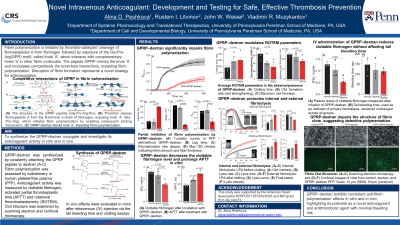Bioengineering (Focus Group – Bioengineering)
(126) Novel Intravenous Anticoagulant: Development and Testing for Safe, Effective Thrombosis Prevention

Introduction: Fibrin polymerization, the final step of blood clotting, is initiated by thrombin cleavage of fibrinopeptides A (FpAs) from fibrinogen. The release of FpA exposes an N-terminal α-chain motif Gly-Pro-Arg (GPR), called knob‘A’, which is complementary to pockets or holes ‘a’ of another fibrin molecule, and this non-covalent ‘A:a’ knob-hole interaction drives fibrin polymerization (1). The peptide GPRP mimics the knob‘A’ structure and competitively inhibits the knob-hole interactions, impairing fibrin polymerization. Disruption of fibrin formation represents a novel strategy for anticoagulation.
Learning Objectives:
- Examine the dose-dependent anticoagulant effects of GPRP-dextran.
- Evaluate GPRP-dextran' window by assessing fibrinogen reduction and normal bleeding time maintenance
- Assess the duration and stability of GPRP-dextran's anticoagulant effects in vivo.
Rustem Litvinov, - – Senior Researcher, Department of Cell and Developmental Biology, University of Pennsylvania; John Weisel, - – Professor, Department of Cell and Developmental Biology, University of Pennsylvania; Vladimir Muzykantov, - – Professor, Department of Systems Pharmacology and Translational Therapeutics, University of Pennsylvania

Alina D. Peshkova, PhD (she/her/hers)
Postdoctoral Research
University of Pennsylvania
Springfield, Pennsylvania, United States

